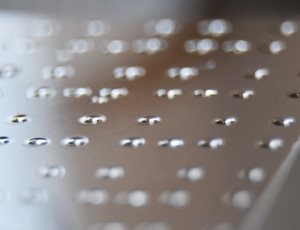Jun 26 2019
Since Roman times, the making of glass objects involved inserting air into a hot glass to form a bubble. In a new research, scientists use these same glass blowing concepts on a microscopic scale to create specialized tiny cone-shaped lenses called axicons.
 A new wafer-level technique uses microscopic glass blowing to form microlenses known as axicons. This photo shows a piece of wafer with the fabricated lenses. (Image credit: Nicolas Passilly, FEMTO-ST Institute)
A new wafer-level technique uses microscopic glass blowing to form microlenses known as axicons. This photo shows a piece of wafer with the fabricated lenses. (Image credit: Nicolas Passilly, FEMTO-ST Institute)
Axicons are used to shape laser light in a manner that is advantageous for optical drilling, imaging and forming optical traps for exploiting particles or cells. These lenses have been around for over 60 years, but their fabrication, particularly when small, is not easy.
“Our technique has the potential of producing robust miniature axicons in glass at a low cost, which could be used in miniaturized imaging systems for biomedical imaging applications, such as optical coherence tomography, or OCT,” said research team member Nicolas Passilly from FEMTO-ST Institute in France.
In The Optical Society (OSA) journal Optics Letters, the scientists explain the new fabrication method, which is based on the same processes used to make large quantities of photonic and electronic circuits in parallel on semiconductor wafers. The scientists used their method to develop glass axicons with diameters of 0.9 and 1.8 mm and demonstrated that they positively produced Bessel beams.
Wafer-level microfabrication allows the axicons to be integrated into more complex microsystems created also at a wafer-level, leading to a system made of a wafer stack. This type of integration comes with better optical alignments, high-performance vacuum packaging and much lower-costs for the final systems because a large number can be processed simultaneously.
Nicolas Passilly, Research Team Member, FEMTO-ST Institute
Creating a microlens
When used with a laser, axicons form a beam of light that starts as a Bessel-like beam — a non-diffracting beam with highest intensity on its axis — and then changes into a hollow beam further away from the axicon. Bessel-like beams have a depth of field that can be orders of magnitude larger than that of a beam focused by a traditional rounded lens with a comparable diameter.
The beam’s high depth of field allows optical drills to reach deeper and develops higher quality OCT images. For optical tweezers, both the Bessel-like and hollow portions of the beam can be used to capture cells or particles.
Methods traditionally used to produce glass axicons can make just a single lens at a time. Although less costly axicons can be created in polymer, these cannot endure high-temperature processes such as wafer-level fabrication or be used in applications that need high levels of light power.
“Polymer axicons can’t be used in optical drilling, for example, because the instantaneous light power is comparable to the power of a nuclear plant but with an extremely short duration,” said Passilly.
Micro glass blowing has been formerly used to create microlenses, but it typically involves gas expansion from a single reservoir. The scientists formulated an axicon fabrication technique that integrates gas expansion from many reservoirs to form the optical component’s conical shape. The method shapes the surface from beneath leaving a high-quality optical surface, in contrast to commonly used approaches like etching transfer from a 3D mask that engrave the wafer from above.
To perform the new micro glass blowing technique, the scientists placed silicon cavities in concentric rings that were then sealed using glass under atmospheric pressure. Positioning the silicon and glass stack in a furnace caused the gas caught in the cavities to expand, forming ring-shaped bubbles. These bubbles forced the glass surface to develop cone shapes and then the opposite side was polished away to leave just the shaped lenses.
Although all the processes we used are standard for microfabrication, we applied these techniques in non-standard ways to make miniature glass axicons. The technique could be applied to create other shapes, even ones without cylindrical symmetry.
Nicolas Passilly, Research Team Member, FEMTO-ST Institute
The scientists aim to add these optical components in OCT devices they are creating for cancer detection and other medical applications.